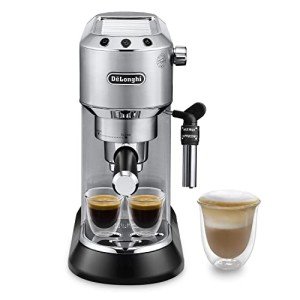10 Myths Your Boss Has Concerning Heat Exchange Espresso Machines
Heat Exchange Espresso Machines: A Comprehensive Guide
Espresso machines have actually developed substantially for many years, dealing with the requirements of home baristas and coffee experts alike. Among these machines, heat exchange espresso machines have actually acquired popularity due to their ability to provide consistent efficiency and extraordinary brew quality. In this post, we will explore the functions, advantages, and crucial features of heat exchange espresso machines, providing a comprehensive understanding for both prospective buyers and coffee enthusiasts.
Understanding Heat Exchange Technology
Heat exchange espresso machines run on a distinct concept that allows simultaneous water heating for brewing and steaming. They are geared up with a single boiler that uses a heat exchanger system. Italian Espresso Machines is substantial as it makes it possible for users to brew espresso while steaming milk concurrently, promoting efficiency in the coffee-making process.
How Does a Heat Exchange Espresso Machine Work?
The procedure starts with the machine's water inlet filling the boiler. As the water warms up, it turns to steam. The ingenious heat exchanger utilizes hot steam to heat additional water in a separate passage created particularly for the brew group. This suggests that water can reach the perfect brewing temperature without awaiting the boiler to change. The key steps consist of:
- Water Fill: Water is drawn into the boiler.
- Heating Process: The boiler warms up as water is converted into steam.
- Heat Exchange: Steam heats up water in the heat exchanger tube.
- Developing: Water from the heat exchanger is pushed through coffee grounds, drawing out the flavors required for an abundant espresso.
This procedure permits fast temperature changes and improved coffee extraction.
Benefits of Heat Exchange Espresso Machines
Heat exchange espresso machines offer several advantages, particularly for those looking to optimize their coffee experience. Here are some crucial advantages:
- Simultaneous Brewing and Steaming: Users can brew espresso while steaming milk, making it ideal for hectic cafes and home baristas who value performance.
- Temperature level Stability: The boiler's steam pressure assists keep a steady temperature, which is critical for consistent espresso extraction.
- Adaptability: The design enables for fast changing between developing and steaming, making it easier to create numerous coffee beverages, from lattes to cappuccinos.
- User-friendly: Models typically come with available controls, making it possible for both beginners and experienced baristas to produce quality beverages.
- Professional Quality: Heat exchange machines are frequently used in commercial settings, offering users with high-quality brewing efficiency in the house.
Key Features to Look for in Heat Exchange Espresso Machines
When thinking about the purchase of a heat exchange espresso machine, there are a number of features that one need to consider:
- Build Quality: Look for machines made from durable products, such as stainless-steel or brass, ensuring longevity.
- Boiler Size: A larger boiler will hold more water and sustain higher output gradually.
- PID Temperature Control: This feature helps maintain consistent brew temperature levels, which can enhance the coffee-making procedure.
- Group Head Design: Machines with a saturated or semi-saturated group head offer much better temperature level stability.
- Ease of Use: User-friendly user interfaces and user-friendly controls enhance the overall experience for baristas at all ability levels.
- Steam Wand Quality: An excellent steam wand with proper insulation and flexibility permits for better texturing of milk.
- Water Reservoir Size: Depending on your requirements, consider how typically you wish to fill up the water tank.
Contrast of Popular Heat Exchange Espresso Machines
To better understand the alternatives available in the market, below is a comparison table of some popular heat exchange espresso machines:
Machine Model
Boiler Size
PID Control
Price Range
User Ratings
Profitec Pro 700
2.0 L
Yes
₤ 2,000-₤ 2,500
9.5/ 10
Rocket Espresso R58
1.8 L
Yes
₤ 2,400-₤ 2,800
9.4/ 10
Elekta Bianca
1.8 L
Yes
₤ 2,500-₤ 3,000
9.6/ 10
La Spaziale S1 Vivaldi II
1.5 L
Yes
₤ 1,800-₤ 2,200
9.2/ 10
Bezzera Magica
1.2 L
No
₤ 1,600-₤ 1,800
9.0/ 10
FAQs About Heat Exchange Espresso Machines
What is the main distinction between a heat exchange and a dual boiler espresso machine?
While both types can brew espresso and steam milk at the very same time, dual boiler machines have separate boilers for brewing and steaming. On the other hand, heat exchange machines use a single boiler and a heat exchanger to attain the exact same function.
Are heat exchange machines appropriate for novices?
Yes! Many heat exchange machines are developed with easy to use features, making them available for newbies. With appropriate guidance and practice, users can quickly produce quality espresso.
What sort of maintenance do heat exchange espresso machines require?
Routine maintenance consists of descaling, cleaning the boiler, examining seals and gaskets, and keeping the group head clean. Regular maintenance makes sure longevity and constant performance.
Can I use a heat exchange machine for various kinds of coffee beverages?
Absolutely! Heat exchange machines allow users to develop a range of coffee drinks, consisting of espresso, lattes, coffees, and more.
Heat exchange espresso machines represent a mix of development and custom, providing coffee lovers with the tools needed for crafting the best cup. Their ability to simultaneously brew and steam, combined with precise temperature control, makes them an engaging option for both home baristas and professionals. With the right knowledge on features and maintenance, users can open a world of elegant coffee experiences, guaranteeing that each sip is as wonderful as the last.
